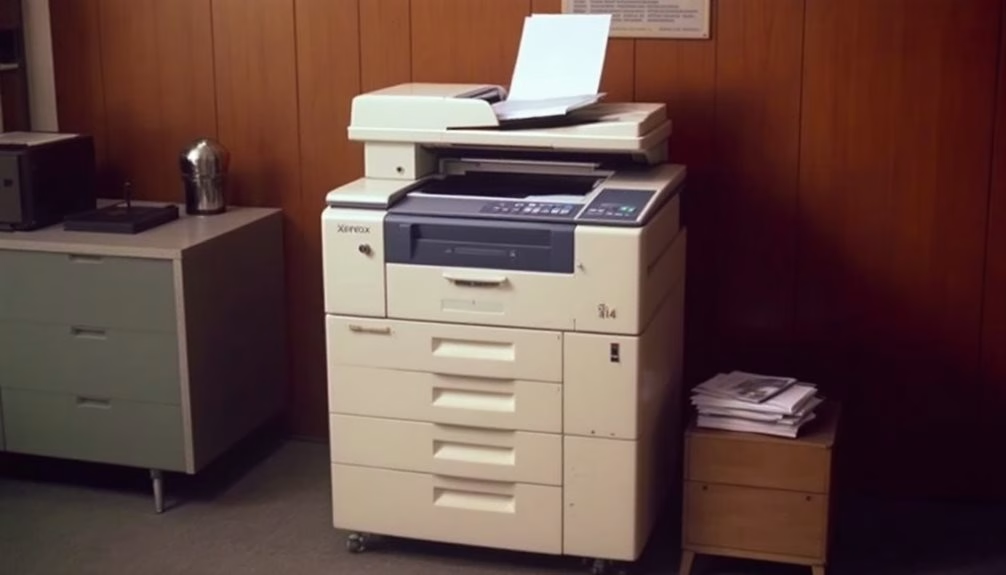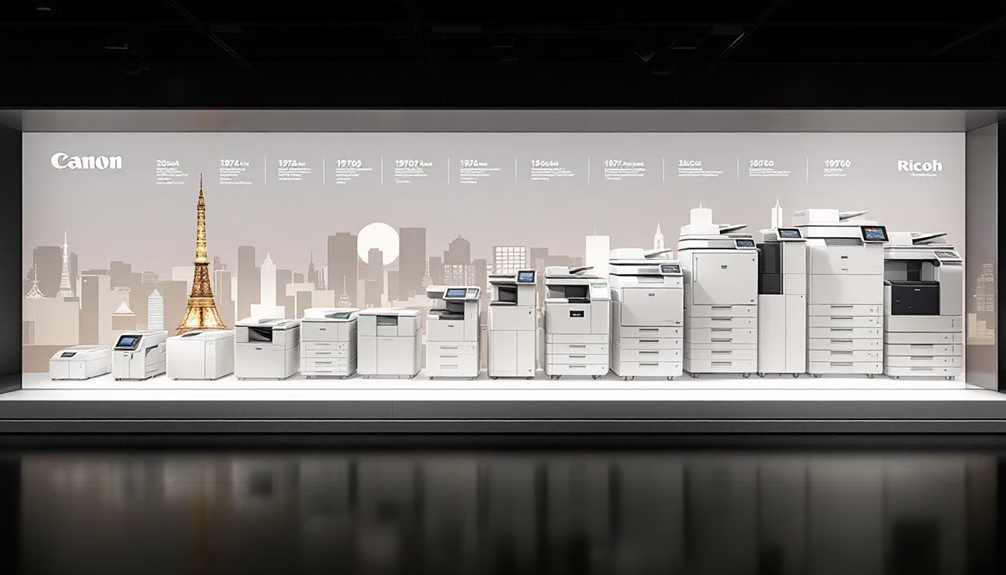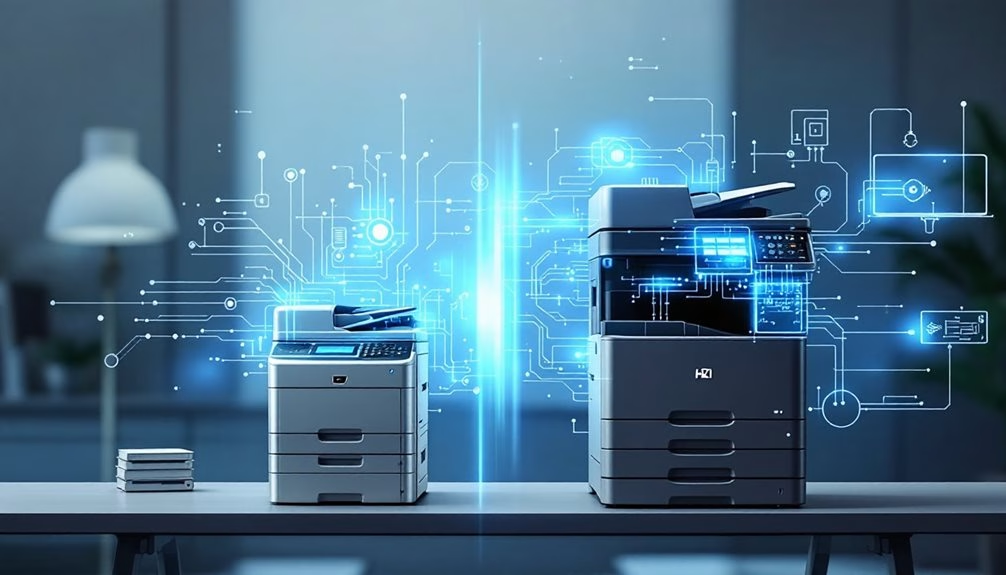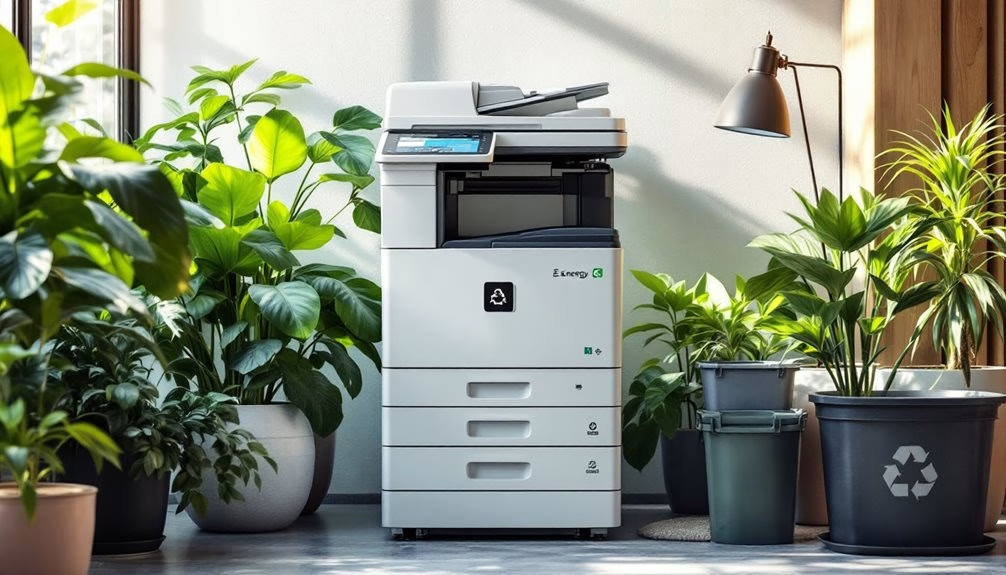The History of Top Copier Brands and Their Impact on Business
May 23, 2025
Modern copier technology began with Chester Carlson’s 1938 xerography breakthrough, but it was Xerox’s 914 model in 1959 that truly revolutionized offices with plain paper copying. Since then, companies like Canon, Ricoh, and Konica Minolta have driven innovation through digital integration, multifunction capabilities, and sustainability initiatives. We’ve seen these brands transform from simple copying machines to networked hubs that enable remote work and efficient document management. The journey continues with AI and cloud solutions reshaping business operations.
Expert Highlights
- Xerox revolutionized office workflows with its 914 copier in 1959, establishing itself as the pioneer in document technology.
- Canon’s innovations in imaging technology and miniaturization made reliable copying accessible to businesses of all sizes.
- The transition to digital multifunction devices in the 1990s integrated printing, scanning, and faxing capabilities into single machines.
- Major brands like Ricoh and Konica Minolta have reduced environmental impact through energy-efficient designs and eco-friendly toners.
- Modern copiers with cloud connectivity and AI integration have reduced operational costs while enhancing document security and remote work capabilities.
The Birth of Modern Photocopying: Xerox’s Revolutionary Plain Paper Technology

The journey of modern photocopying began with a eureka moment in a small laboratory. Chester Carlson’s 1938 breakthrough, “10-22-38 Astoria,” marked the first electrophotographic image, later known as xerography.
We can trace Xerox’s dominance to 1959 when they introduced the revolutionary 914 copier. Unlike earlier technologies using chemically treated paper, Xerox’s innovation let’s copy onto plain paper—transforming office work forever.
The 914 copier didn’t just improve on predecessors—it reimagined reproduction itself through the revolutionary simplicity of plain paper.
This technology democratized document reproduction, creating a shared experience across businesses worldwide.
We’ve all stood by a Xerox machine, waiting for our copies—a ritual that’s become part of our collective professional identity.
Today’s businesses can benefit from flexible leasing options that make these essential technologies accessible without significant upfront investment.
Japanese Innovation: How Canon and Ricoh Changed the Competitive Landscape

We’ll now examine how Canon and Ricoh revolutionized the copying industry through significant miniaturization breakthroughs.
Their engineering innovations created smaller, more reliable machines that challenged Xerox’s market dominance throughout the 1970s and 1980s.
As these Japanese manufacturers expanded globally, they transformed their business strategies to accommodate diverse international markets, ultimately reshaping the competitive landscape of the office equipment industry.
Today, Ricoh continues this tradition of excellence with award-winning multifunction devices designed for reliability, advanced security features, and seamless integration with modern cloud services.
Miniaturization Breakthroughs Drive Success
While American companies like Xerox dominated the early photocopier market, Japanese manufacturers Canon and Ricoh revolutionized the industry through groundbreaking miniaturization techniques in the 1970s and 1980s.
We’ve all experienced the transformation from room-sized copiers to desktop machines that fit comfortably in our offices.
This shift came from three key Japanese innovations:
- Microprocessor integration that replaced bulky analog components
- Cartridge-based systems that simplified maintenance for everyday users
- Optical advancements that reduced lens size while improving image quality
These breakthroughs didn’t just create smaller machines—they democratized access to copying technology, bringing us together through shared productivity tools we now take for granted.
Global Markets Transform Strategy
As Japanese manufacturers entered Western markets in the 1980s, they fundamentally reshaped the competitive landscape of the photocopier industry.
Canon and Ricoh introduced innovative products with better reliability and competitive pricing, forcing established players like Xerox to rethink their strategies.
We’ve witnessed how these Japanese brands leveraged their manufacturing efficiency and quality control expertise to win market share.
They introduced just-in-time production and thorough service networks that we now consider industry standards.
Their success wasn’t accidental—it reflected a deliberate approach to understanding global customer needs and adapting quickly to local market conditions.
The Digital Revolution: From Analog Machines to Smart Multifunction Devices

The remarkable transformation of copiers began in the late 1990s when digital technology revolutionized what was once a simple analog machine.
We’ve witnessed these devices evolve into the intelligent workplace hubs we rely on today.
This evolution brought us three key improvements:
- Network connectivity that integrated copiers with our digital workflows
- Multi-functionality combining printing, scanning, faxing, and copying in one device
- Smart features including cloud integration, mobile printing, and advanced security
We’re now part of a workplace where these machines don’t just reproduce documents—they’ve become central to how we communicate, collaborate, and secure our information.
Today’s multi-function printers help businesses overcome document chaos challenges while reducing total cost of ownership by up to 30%.
Environmental Responsibility: How Copier Brands Embraced Sustainability

Environmental concerns have transformed the copier industry since the early 2000s, leading major brands to reimagine their products with sustainability at the core. We’ve witnessed remarkable innovations as companies compete to develop the greenest solutions for our workplaces.
| Brand | Key Initiative | Impact |
|---|---|---|
| Xerox | Paper-Saving Technology | 35% reduction in waste |
| Canon | Energy Star Compliance | 40% less power consumption |
| Ricoh | Eco-Friendly Toners | Biodegradable components |
| HP | Recycling Programs | 90% cartridge recovery |
| Konica Minolta | Carbon Neutrality | Zero net emissions by 2030 |
Together, we’re participating in this green revolution every time we choose sustainable office equipment. Modern Managed Print Services promote sustainability through energy-efficient devices and responsible recycling practices that further reduce environmental impact.
The Networking Era: Copiers as Connected Office Hubs

Modern offices have witnessed a remarkable transformation as standalone copiers evolved into sophisticated networking hubs.
We’ve seen copier brands revolutionize connectivity by integrating multifunction devices into our digital ecosystems, transforming how we collaborate.
Key developments in this networking revolution include:
- Cloud integration enabling remote printing and document management
- Mobile compatibility allowing us to print directly from our smartphones
- Enhanced security protocols protecting our sensitive information in shared environments
We’re no longer just making copies—we’re connecting our entire workflow through these intelligent machines.
Brands like Xerox, Canon, and Ricoh have redefined our expectations, making document management more intuitive and inclusive for everyone in our organizations.
From floor-standing models to compact desktop options, businesses can select the perfect networking solution based on their specific volume needs and space constraints.
Beyond Paper: How Today’s Brands Are Redefining Document Management
While traditional copiers focused primarily on reproducing physical documents, today’s innovative brands have fundamentally reimagined what document management means in our increasingly digital workplace.
We’re now seeing intelligent systems that capture, store, and distribute information across our organizations. Canon, Xerox, and Ricoh lead with cloud integration that lets us access documents anywhere.
HP and Konica Minolta offer enhanced security features protecting our sensitive data. These brands understand we need more than paper copies—we need seamless workflows.
Together, we’re embracing these solutions that transform isolated printing tasks into collaborative experiences connecting our teams across platforms and devices.
Frequently Asked Questions
How Did Copier Pricing Models Evolve Throughout Industry History?
We’ve seen copier pricing evolve from simple purchase models to complex arrangements including leasing, cost-per-page, bundled services, and subscription options that we can tailor to our unique needs.
Which Discontinued Copier Brands Once Dominated the Market?
We’ve seen giants fall in our industry. Mita, Savin, Minolta, and AB Dick once dominated our copier landscape before disappearing through mergers or bankruptcy, leaving nostalgic memories for many of us.
What Security Features Protect Sensitive Documents in Modern Copiers?
We rely on encryption, user authentication, hard drive wiping, network security protocols, and audit trails to protect our sensitive documents. Modern copiers now offer automatic data deletion and secure print features too.
How Do Independent Service Providers Impact the Copier Industry?
We’ve seen independent service providers disrupt the copier industry by offering lower-cost maintenance, third-party supplies, and personalized support that challenges manufacturer monopolies while giving us more flexible options for our office needs.
Which Copier Innovations Failed Despite Heavy Manufacturer Investment?
We’ve seen several copier flops despite major investments: Kodak’s Photo CD, Xerox’s Star workstation, Canon’s LIPS, and IBM’s eCopy—all technologies we thought would revolutionize our document management world.
Expert Final Thoughts
Throughout our journey from Xerox’s breakthrough to today’s smart document hubs, we’ve seen how copier brands have transformed business operations. They’ve pushed boundaries in innovation, sustainability, and connectivity. As we look ahead, we’ll witness these companies continue to redefine how we manage information. Copiers aren’t just machines—they’re catalysts for workplace evolution that have forever changed how we do business.
About the Expert
Rafael M.
CEO of JR Copier
With over 35 years of hands-on experience in the copier and office printer industry, Rafael brings unparalleled expertise to every client interaction. His journey from service technician to CEO provides him with comprehensive understanding of all aspects of the business.
Areas of Expertise: Copier and printer sales, equipment leasing strategies, maintenance solutions, and managed print services. Rafael's deep industry knowledge ensures clients receive expert guidance, transparent pricing, and exceptional service for all their office equipment needs.
Connect on LinkedIn